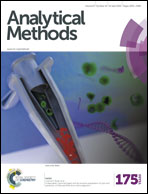The development of a novel chemiluminescent glucose sensor using hydrophilic Co3O4@SiO2 mesoporous nanoparticles
Abstract
Herein, we present a novel chemiluminescent (CL) sensor combined with an enzyme immobilization technique. We propose a versatile approach for the fabrication of CL sensors based on hydrophilic Co3O4@SiO2 mesoporous nanoparticles. The Co3O4@SiO2 mesoporous nanoparticles immobilized on the 96-well plates exhibited higher catalytic activity on the luminol–H2O2 CL reaction in an alkaline medium. Enzyme reactors were fabricated by incorporating functionalized mesoporous silica particles into calcium alginate fiber (CAF) to efficiently encapsulate the enzyme. The novel CL sensors combined with the enzyme reactors were reversible and reusable, which have been successfully exploited towards the high-throughput determination of glucose in human serum. The method was based on the generation of H2O2 from glucose in human serum by immobilized glucose oxidase (GOD). The linear range of the glucose concentration was 1.0 × 10−6 to 8.0 × 10−5 M and the detection limit was 1.2 × 10−7 M.


 Please wait while we load your content...
Please wait while we load your content...